Free employee warning letter template: You must make an employee warning letter when you run a company, a club, or an organization. For those who do not know, an employee warning letter is used to warn the employees when they do something inappropriate which can negatively impact the company or other employees.
Not only will the misconduct affect the employee’s productivity, but it will also lead to disrespect of the management, colleagues, and juniors. Worse, the misconduct will eventually lead to chaos if handled immediately.
One of the best ways to stop the misconduct is by composing an employee warning letter to the employee who has committed the misconduct. Commonly, the employer will give the employee a talk before giving them the warning letter.
You can use it in many situations, but remember that the sole purpose of this warning letter is to point out misconduct or wrongdoing.
What Is It?
An Employee Warning Letter is a formal document you give an employee. It points out misconduct or wrongdoing at work.
Reasons to Use the Warning Letter
Sometimes, people at work don’t do a good job or act in a way that’s not nice. It can make the workplace less fun for everyone else. When this happens, the boss may give them a Warning Letter. Here’s why a warning letter can be helpful.
To Help People Do Better at Work
- Not Doing Work Right: If someone is not doing their job as they should, a letter can help them know what to fix.
- Missing Time to Finish Work: Sometimes, people need to finish their work on time. A letter can remind them to be faster.
To Make Sure People Act Nice
- Coming Late: Being late is not good because it makes it hard for everyone else.
- Not Telling When Absent: If someone doesn’t come to work or tell anyone, that’s fine.
To Keep Rules Safe
- Sharing Secrets: Some stuff at work is secret. If someone tells these secrets, they could get a warning letter.
- Not Being Safe: It’s important to be safe at work. If you’re not, you could get a letter.
To Stop Bad Choices
- Drinking or Taking Drugs: Doing this at work is very bad.
- Lying About Skills: Some people say they can do things they can’t. That’s not good.
To Keep People Safe
- Being Mean or Dangerous: If someone acts in a way that could hurt others, they might get a warning.
To Make Sure People Are Respectful
- Being Rude to the Boss: Everyone should be nice to the boss and each other.
For Legal Stuff
- Breaking a Work Contract: Sometimes, there are rules in a paper you sign when you start working.
- For Law Reasons: Sometimes, the law says that a person has to get a warning if they do something bad.
To Keep Records
- Writing it Down: A warning letter helps keep track of what happened. It is good for the company and the workers.
So, a warning letter is a way to fix problems at work. It tells the person what they did wrong and how to improve. It is good for everyone at work!
When to Use a Warning Letter
Best Times to Use It
Choosing the right time to give an Employee Warning Letter is crucial. If given too late, the misconduct might become a habit. If given too early, it might create unnecessary tension.
Common Scenarios for Use
Here are some situations where a warning letter might be needed:
- Frequent Tardiness: If the employee is often late, it disrupts workflow.
- Poor Performance: An employee’s work needs to be better.
- Unexplained Absences: Missing work without giving any notice can affect the team.
- Breaking Company Policy: Like not following the dress code or using office property inappropriately.
- Safety Violations: Ignoring safety guidelines is a big no-no.
- Confidentiality Breaches: Leaking company secrets is very serious.
- Disruptive Behavior: Actions that disturb colleagues or create a hostile environment.
- Drug and Alcohol Violations: Coming to work under the influence.
- Misrepresentation: Lying about qualifications or work completed.
- Theft or Vandalism: Stealing or damaging company property.
The “Talk” Before the Letter
Before issuing a warning letter, talking face-to-face with the employee is often good. It should be a two-way conversation where you:
- Explain what the issue is
- Ask for their side of the story
- Discuss possible solutions
Sometimes, this conversation alone can resolve the problem. However, a follow-up with a written warning is often a good practice for documentation.
Precautions to Take
- Check Employee Handbook: Ensure you know your company’s rules about warning letters.
- Consult HR: Consult your Human Resources department for guidance is often wise.
- Legal Review: Depending on the severity, you should get a legal opinion to avoid potential issues.
What Element Should You Include in the Employee Warning Letter?
An Employee Warning Letter is a formal document containing specific information to be effective and legal. Below are key components that should be part of your warning letter.
Basic Elements
- Date: The date the letter is being sent to establish a timeline.
- Employee Details: Include the employee’s full name, job title, and department.
- Company Details: The company’s name and often the department where the employee works.
Introductory Statement
Briefly mention why the letter is being written. Make sure to specify that it serves as an “official warning.”
Description of Misconduct
- Specific Event (s): Clearly describe what the employee did wrong. Use dates, times, and locations if possible.
- Company Policy: Cite the specific rule or policy that has been violated.
Consequences
- Immediate Consequences: Explain what will happen right away. It could be a probation period or a demotion.
- Future Consequences: Make it clear what will happen if the misconduct continues. It could range from further disciplinary actions to termination.
Expectations Moving Forward
Outline what changes you expect to see, including:
- Performance Goals: What they need to improve, with clear benchmarks.
- Behavior Changes: Specify any changes in behavior that need to occur.
Opportunity for Rebuttal
Indicate that the employee can respond in writing or during a formal meeting.
Closing
- Manager’s Name: The person issuing the warning should sign the letter.
- Human Resources Contact: Information for who to talk to in HR for more details or if they wish to dispute the warning.
Attachments
Include any evidence or records that support the warning. It might be past performance reviews, email correspondence, or incident reports.
Additional Notes
- Copy to HR: Always ensure a copy of the warning letter is sent to Human Resources for record-keeping.
Types of Warning Letters to Employees
Warning letters are important in the workplace. They tell employees when something is wrong. Let’s look at all the kinds of warning letters.
- Warning Letter to Employee PDF: You can’t change this type, but you can print it.
- Warning Letter to Employee Word: You can change this with your computer.
- Warning Letter to Employee for Unprofessional Behavior: You get this letter if you act badly at work.
- Warning Letter to Employee for Poor Performance: This is for doing your job badly.
- Warning Letter to Employee for Absence: If you’re not at work and didn’t say why, this is the letter you get.
- Warning Letter to Employee for Negligence of Work: This is for making mistakes you shouldn’t make at work.
- Warning Letter to Employee for Misconduct: This is for doing something bad, like stealing.
- Warning Letter to Employee for Unacceptable Behavior: You get this letter if you do something that is not okay at work.
- Warning Letter to Employee for Leave Without Information: If you leave work and don’t tell anyone, you get this letter.
- Warning Letter to Employee for Non-Compliance: This is for when you don’t follow the rules.
- Final Warning Letter to Employee for Misconduct: This is a very serious. You might lose your job if you get this one.
- Warning Letter to Employee for Disclosing: This one is for telling secrets you shouldn’t tell.
- Warning Letter to Employee for Gossiping: This is for talking about other people badly.
- Warning Letter to Employee for Not Following Procedures/Rules: This is for incorrectly doing things.
- Warning Letter to Employee for Watching Movies at Work: Work is not movie time! This letter says you have to stop.
- Late Warning Letter to Employee: You get this letter if you are late a lot.
Always remember warning letters are serious. If you get one, you should talk to the HR (Human Resources) people at work. They will tell you what to do next.
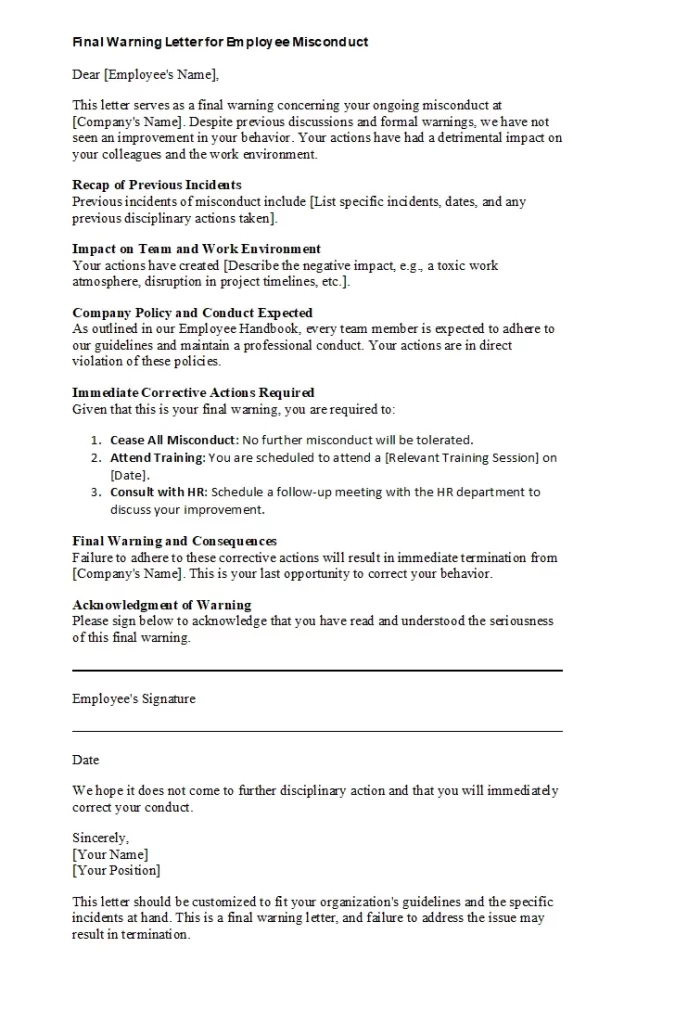
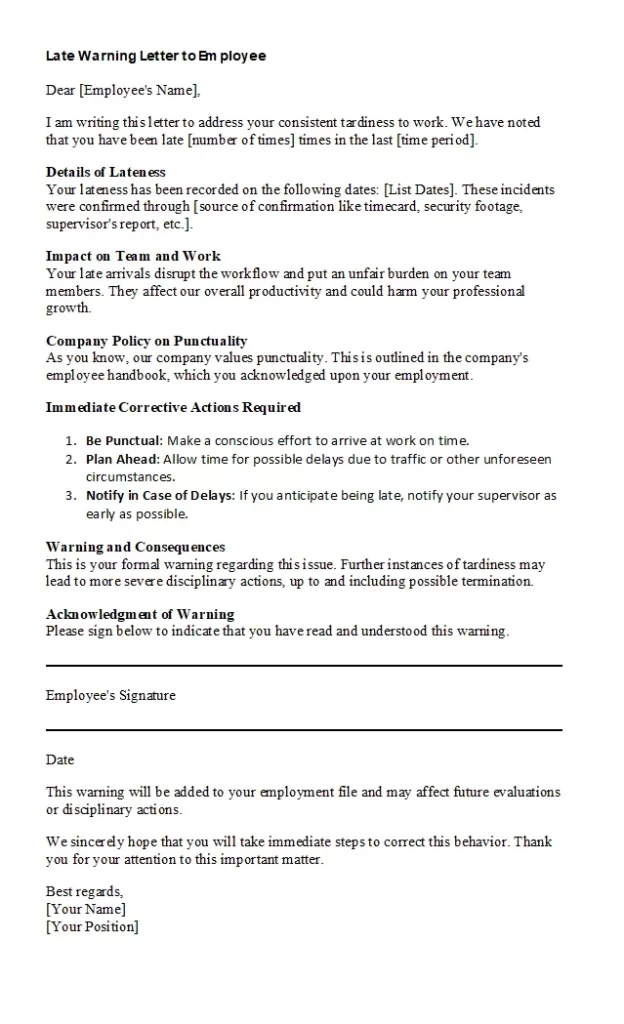
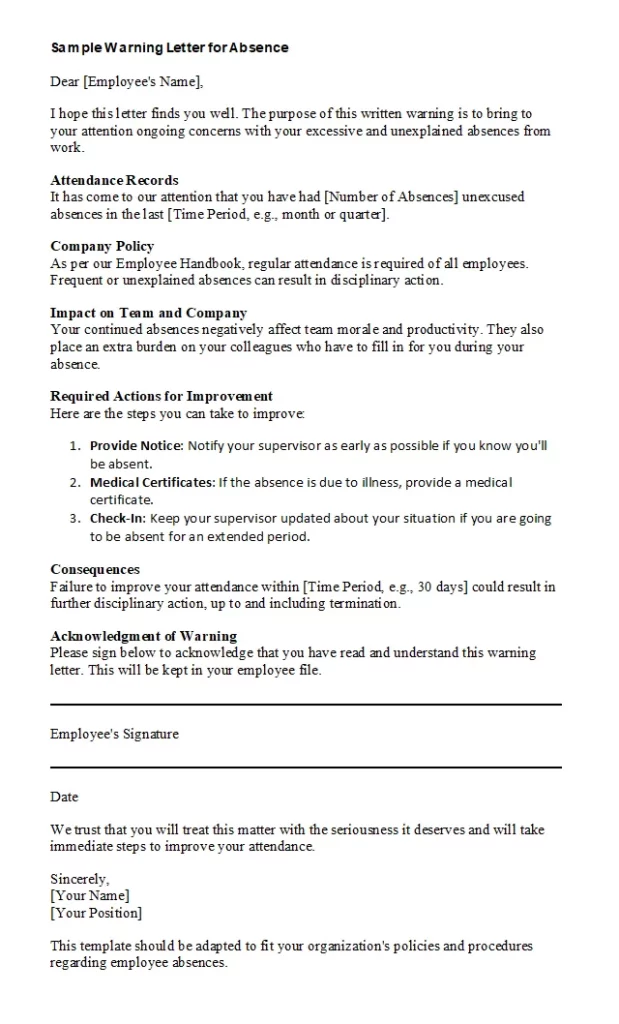
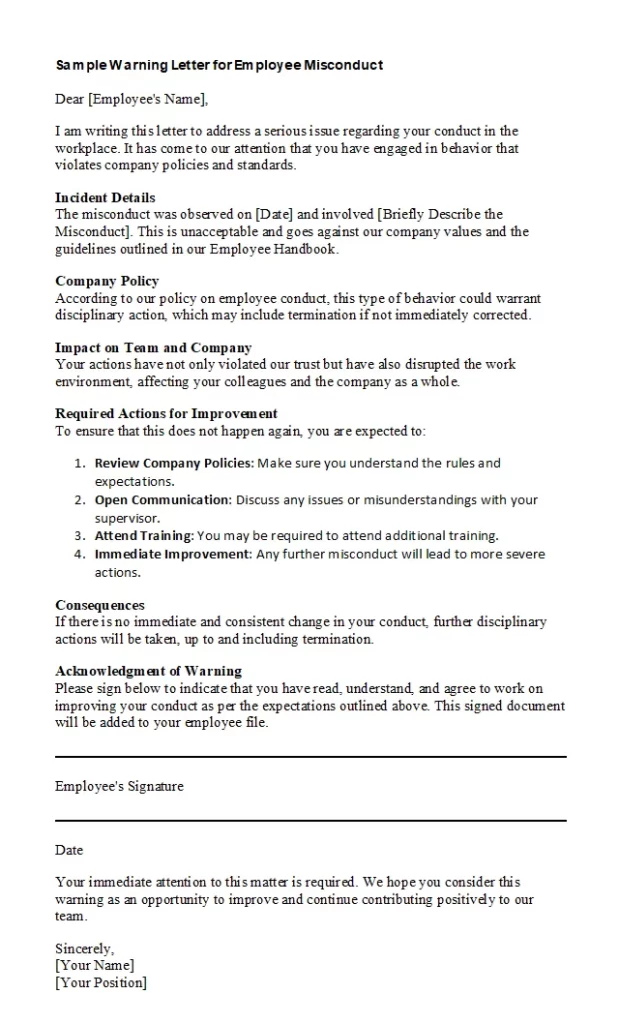
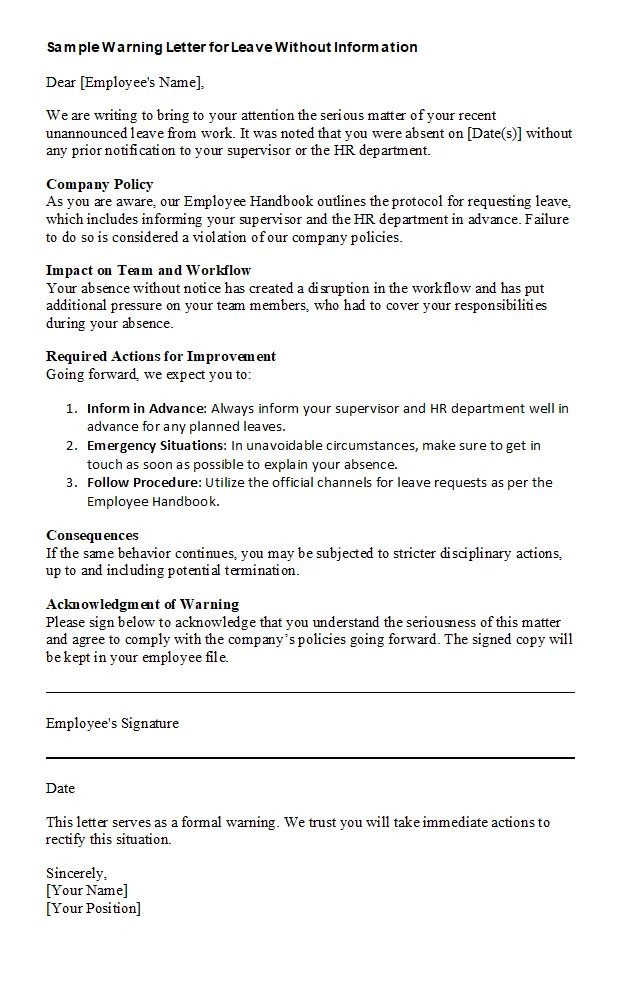
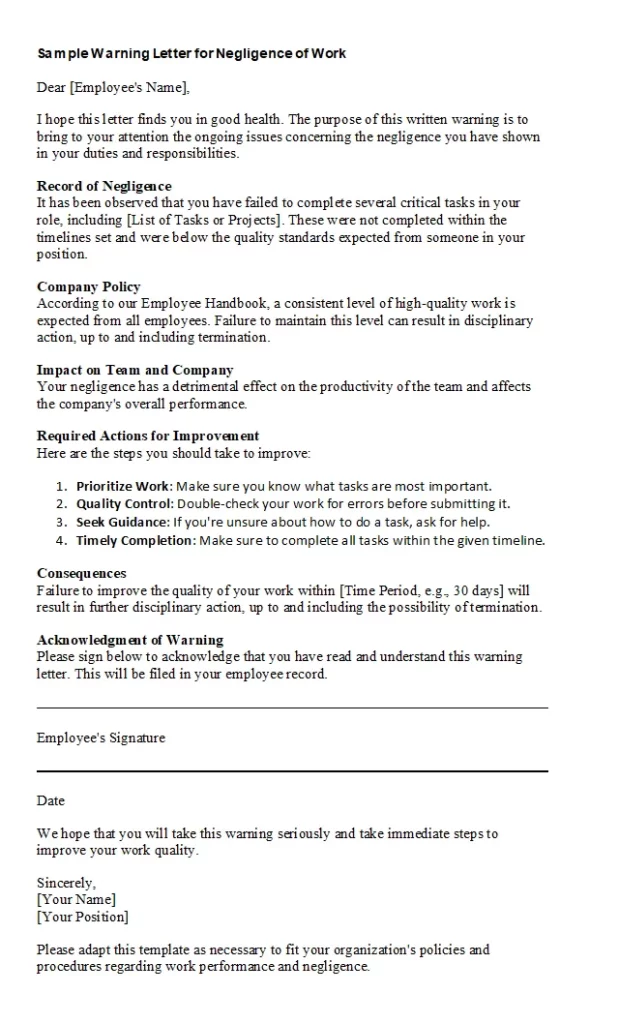
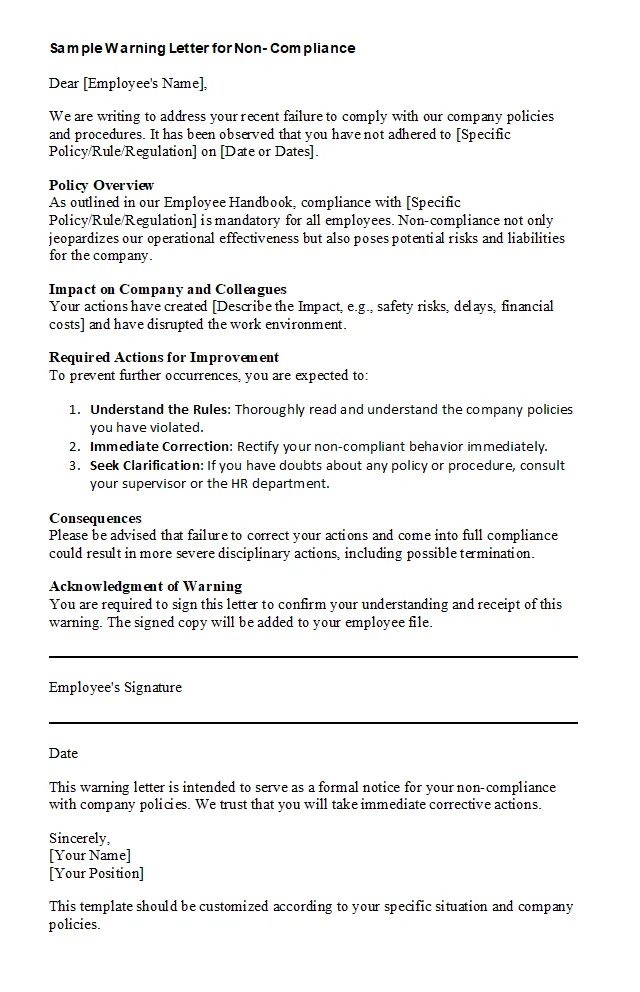
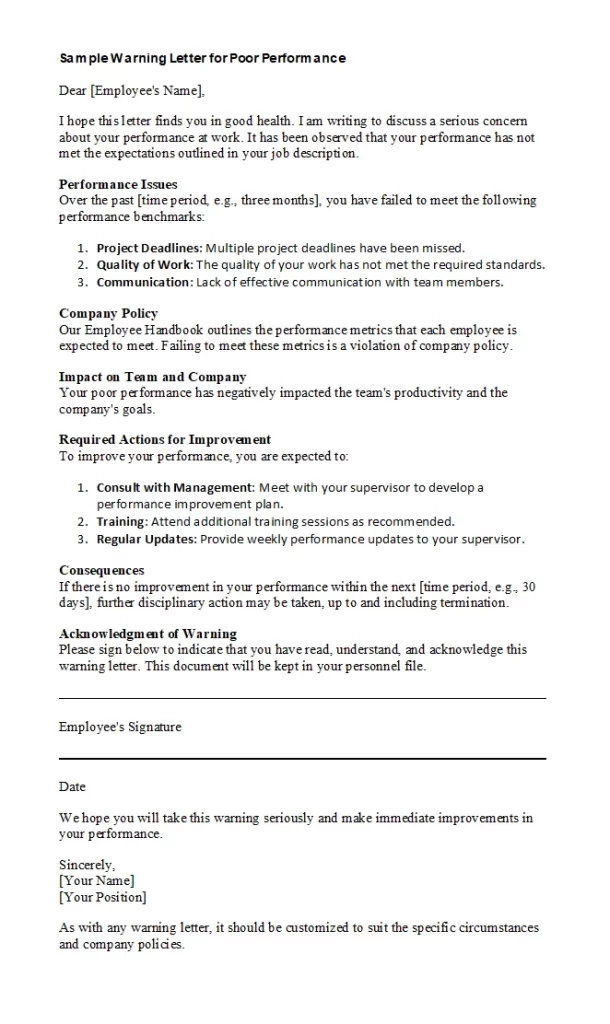
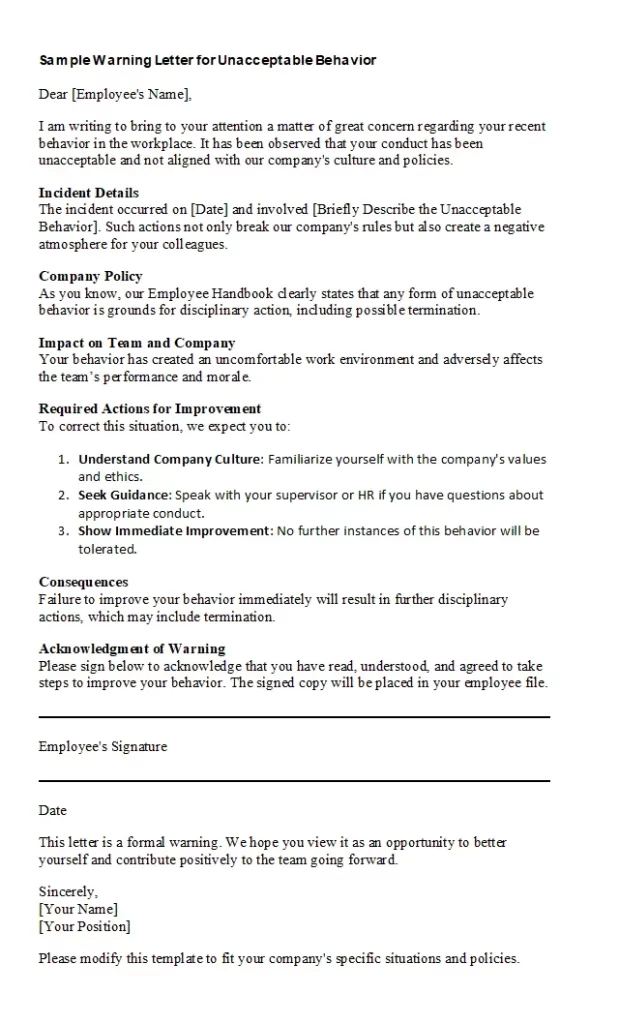
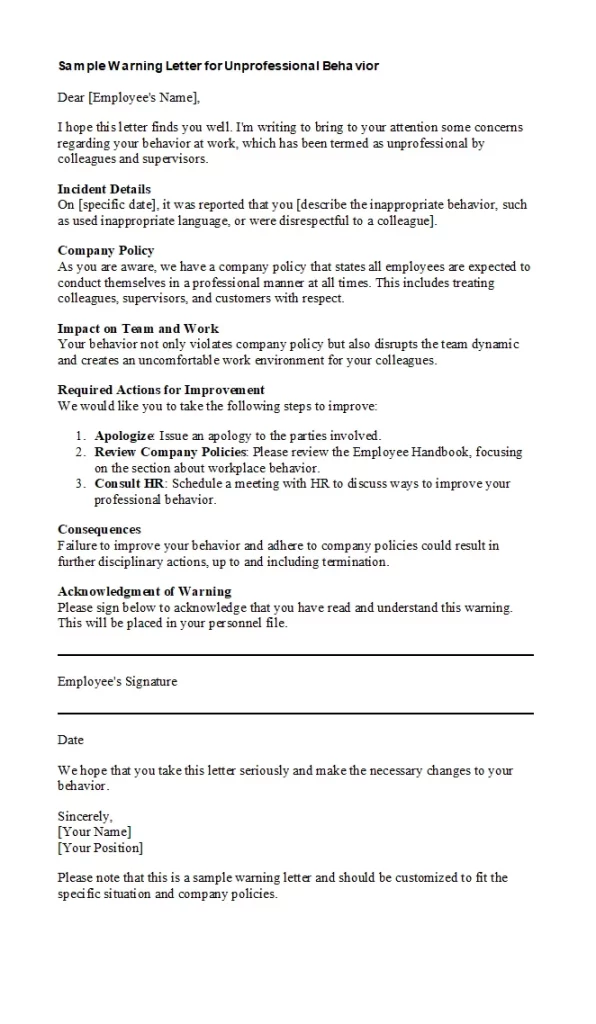
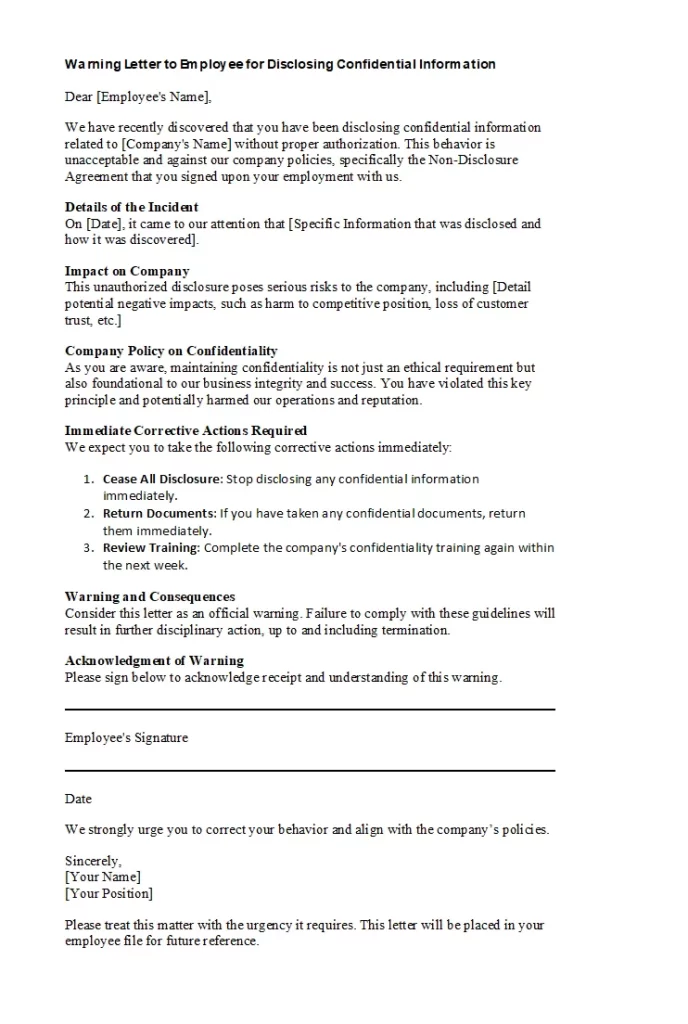
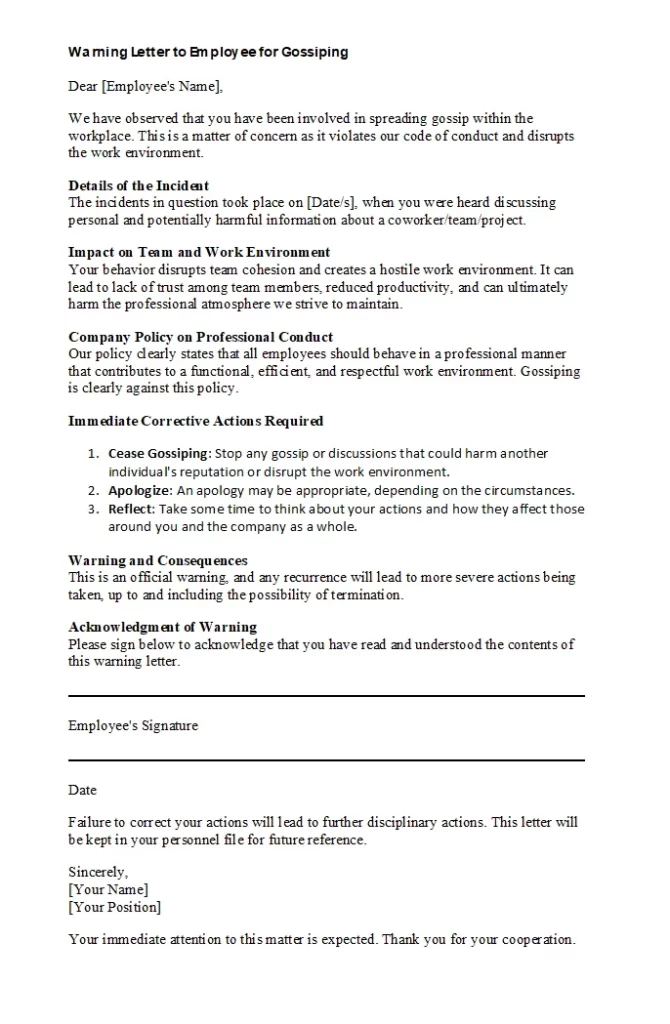
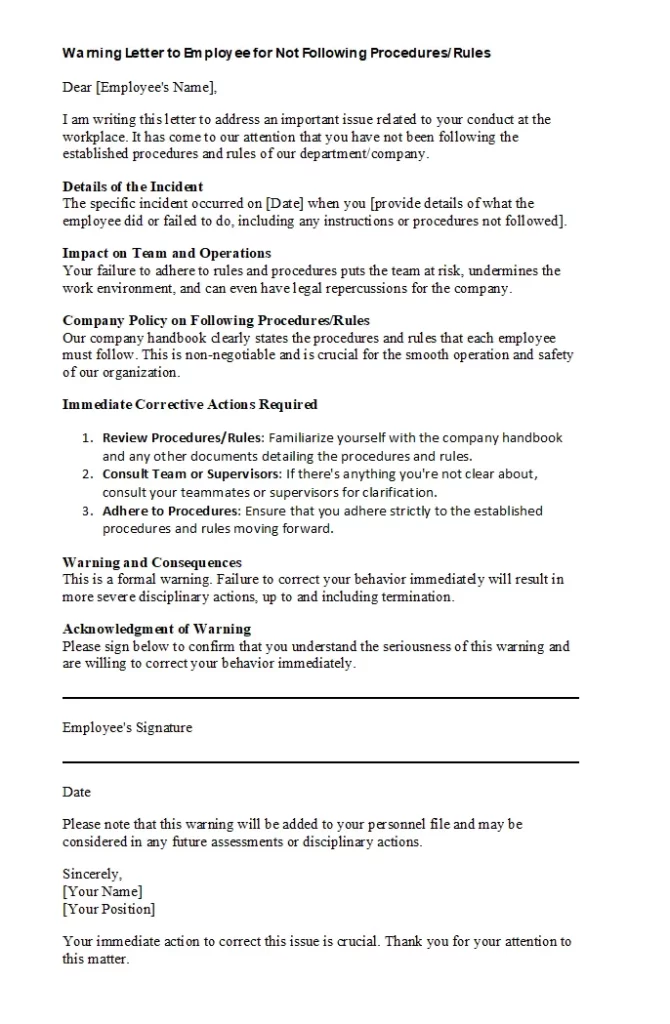
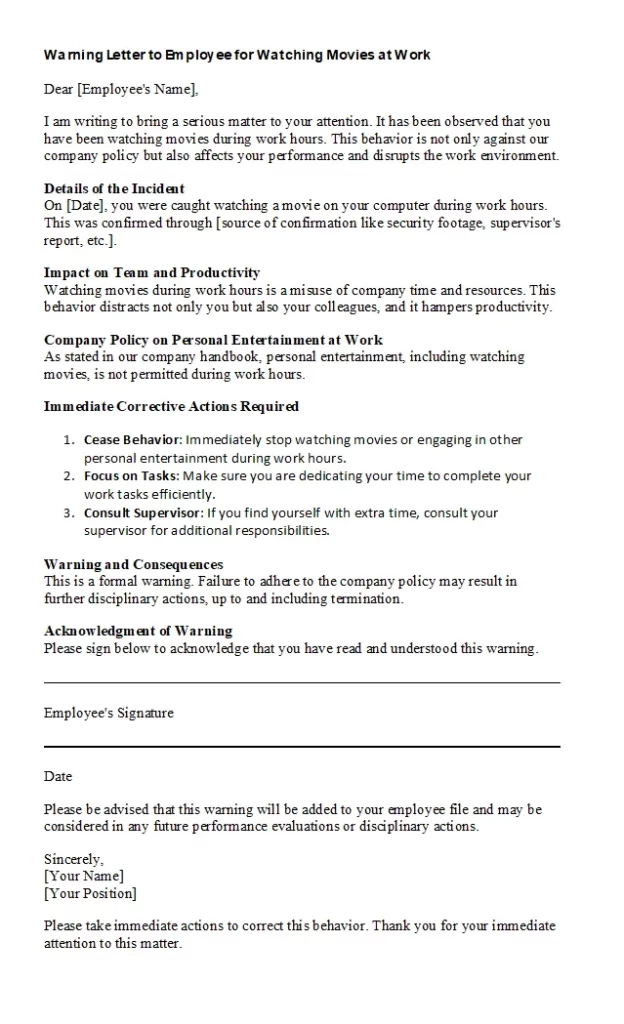
Free Employee Warning Letter Template
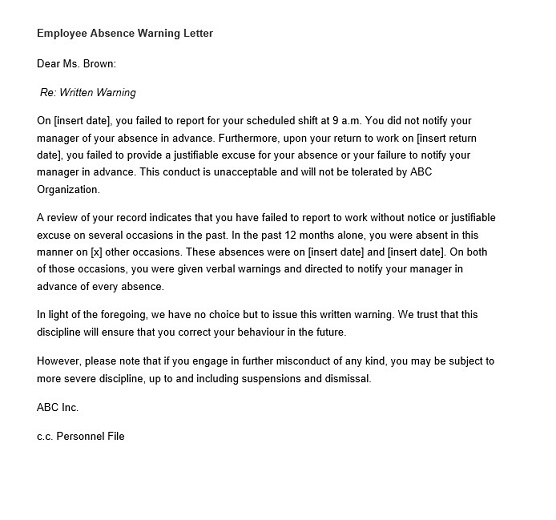
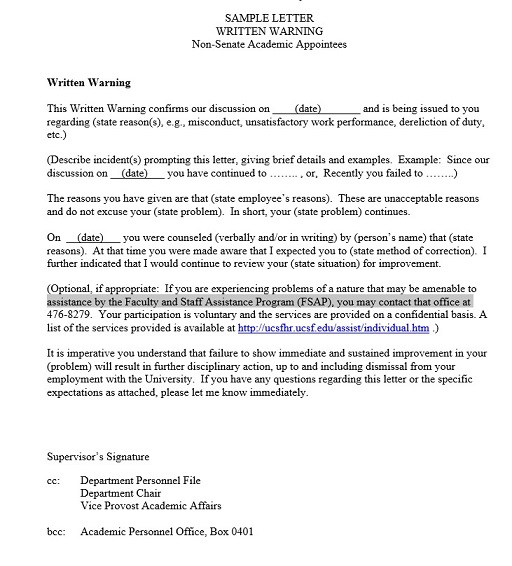
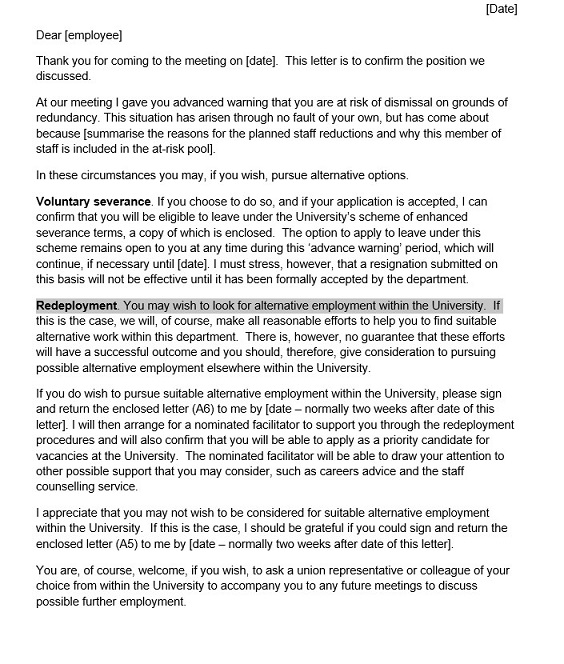
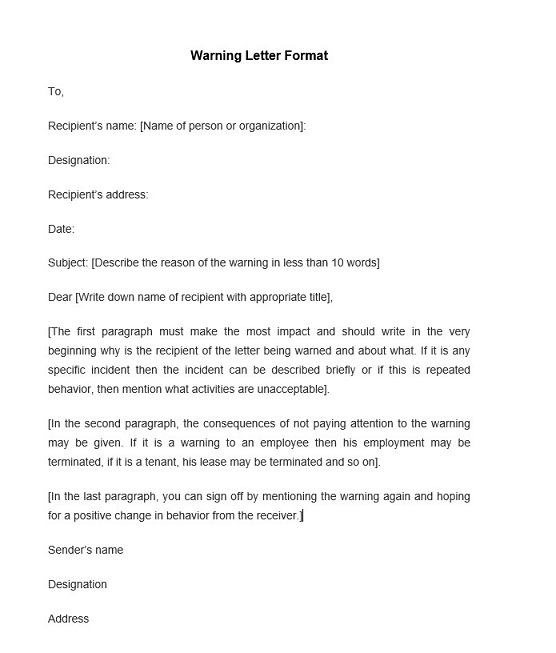
Customizing Your Warning Letter
Every workplace and situation is unique, so your employee warning letters should be, too. Customization letter addresses the company’s policies and culture. Here’s how to customize your warning letters effectively.
Understand Company Policy
- Refer to Handbook: Revisit your company’s handbook or code of conduct before writing. Tailor the language of your letter to match that of official documents.
Identify the Issue Clearly
- Pinpoint the Problem: Use a variety of approaches. Make sure to identify the specific issue or misconduct in question.
- Link to Company Policy: Explicitly state which rule or policy the employee has violated.
Personalize Employee Information
- Name and Title: Always include the employee’s full name, job title, and department to make the letter specific to them.
- Add Date and Time: Insert the date and possibly the event time that prompted the warning letter.
Use Appropriate Tone
- Culture Matters: Your company culture dictates the tone of the letter. A startup might use a more casual tone, while corporate environments require formal language.
Provide Context
- Situation Details: Include any context that could make the warning clearer. It could be prior verbal warnings, or it’s a first-time occurrence but a severe one.
Specify Consequences
- Tailor to Offense: The gravity of the violation should dictate the severity of the consequence. Customize this section to spell out what happens next, whether it’s another warning, a demotion, or even termination.
Offer a Path Forward
- Individual Plan: Offer solutions tailored to the employee’s situation. It could be additional training, mentorship, or more frequent check-ins.
Add a Call to Action
- Next Steps: Clearly state what the employee needs to do next. Whether it’s a follow-up meeting or a deadline for improvement, make this part specific to their situation.
Legal Addendums
- State Law: If your state has specific legal requirements for warning letters, include those.
Signature Lines
- Both Parties: Customize this part to include lines for signatures from the employee and the person issuing the warning.
Common Mistakes To Avoid
Here are some common mistakes you should avoid.
Being Too Vague
- The Problem: If the letter doesn’t clearly say the issue, the employee won’t know how to fix it.
- The Fix: Be clear and specific about what the employee did wrong.
Forgetting Important Details
- The Problem: Missing out on dates, incidents, or broken rules.
- The Fix: Double-check to ensure all important information is in the letter.
Not Following Company Policy
- The Problem: Each company has its own rules about warning letters.
- The Fix: Know your company’s rules and follow them.
Being Too Harsh or Too Soft
- The Problem: The employee may feel attacked if the tone is too harsh. If it’s too soft, they may not take it seriously.
- The Fix: Be professional and fair in your language.
Skipping the Steps for Improvement
- The Problem: The letter should help employees improve, not just tell them what they could have done better.
- The Fix: Include steps or suggestions for how to improve.
No Signature
- The Problem: With a signature, the letter may seem official.
- The Fix: Always sign the letter and ask the employee to sign it, showing they received it.
Forgetting to Review and Edit
- The Problem: Spelling errors or bad grammar can make the letter look unprofessional.
- The Fix: Proofread the letter or ask someone else to check it.
Not Keeping a Copy
- The Problem: You need to keep track of all warnings given.
- The Fix: Always keep a copy of each letter in the employee’s file.
Sending Without Prior Discussion
- The Problem: The warning letter shouldn’t be a surprise.
- The Fix: Usually, there should be a talk with the employee before they get the letter.
Using a One-Size-Fits-All Template
- The Problem: Every situation is different, and using the same template may be ineffective.
- The Fix: Customize each warning letter to fit the specific issue and employee.
Conclusion
Free employee warning letter template – Those are the explanations for employee warning letters. Be sure to give one to the misbehaved employee to reduce the negative impact on your company.
So, there you have it! An Employee Warning Letter is a key tool for good management. Use our guide to help you make one that works.
FAQs
What is an Employee Warning Letter?
- It is a note from the boss that tells someone they did something wrong at work.
Who Gets the Warning Letter?
- The person who did something wrong gets the letter. Usually, the boss or someone from human resources gives it to them.
Does Everyone Know About the Letter?
- No, it’s usually private between the person who gets it and the boss or human resources.
What Happens After Getting a Letter?
- The person should try to fix what the letter says is wrong. If they don’t, there might be more trouble, like getting another letter or losing the job.
Can I Say No to the Letter?
- You can talk to your boss or human resources if the letter needs to be more fair. But the letter is usually a serious thing.
Do Warning Letters Go on My Record?
- Yes, usually, the company keeps a record of the letter. It helps them remember what happened.
How Many Warning Letters Can I Get?
- It depends on the company’s rules. Some places might give you a few warnings, but others might be stricter.
What if I Fix What the Letter Says?
- If you fix the problem, usually everything goes back to normal.
Can the Letter Be Taken Back?
- Sometimes, if you do well after getting the letter, it might be removed from your record. But this is up to the company.
Do All Companies Use Warning Letters?
- Not all companies use them, but many do.

The content creator team at calipsotree.com is dedicated to making topics accessible to everyone, with over 9 years of experience in writing and breaking down complex concepts into easy-to-understand articles that answer readers’ financial questions.








